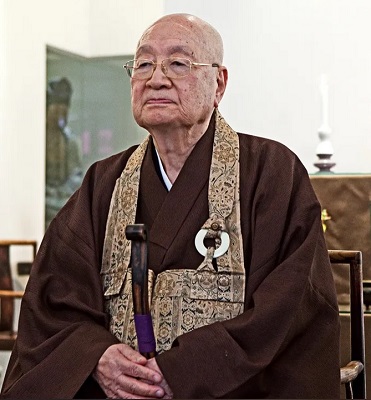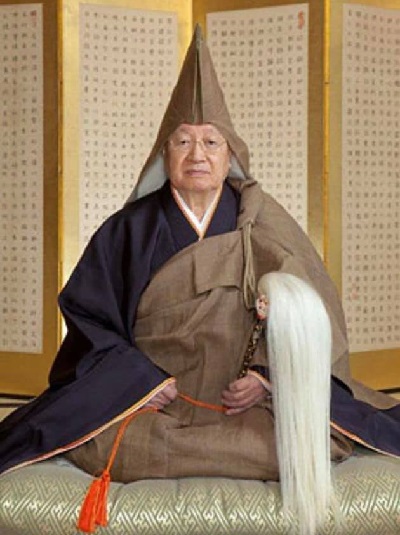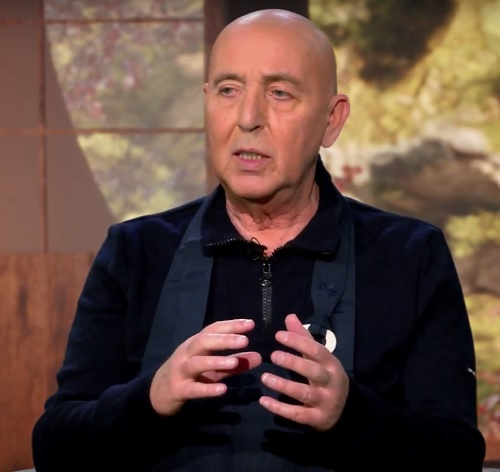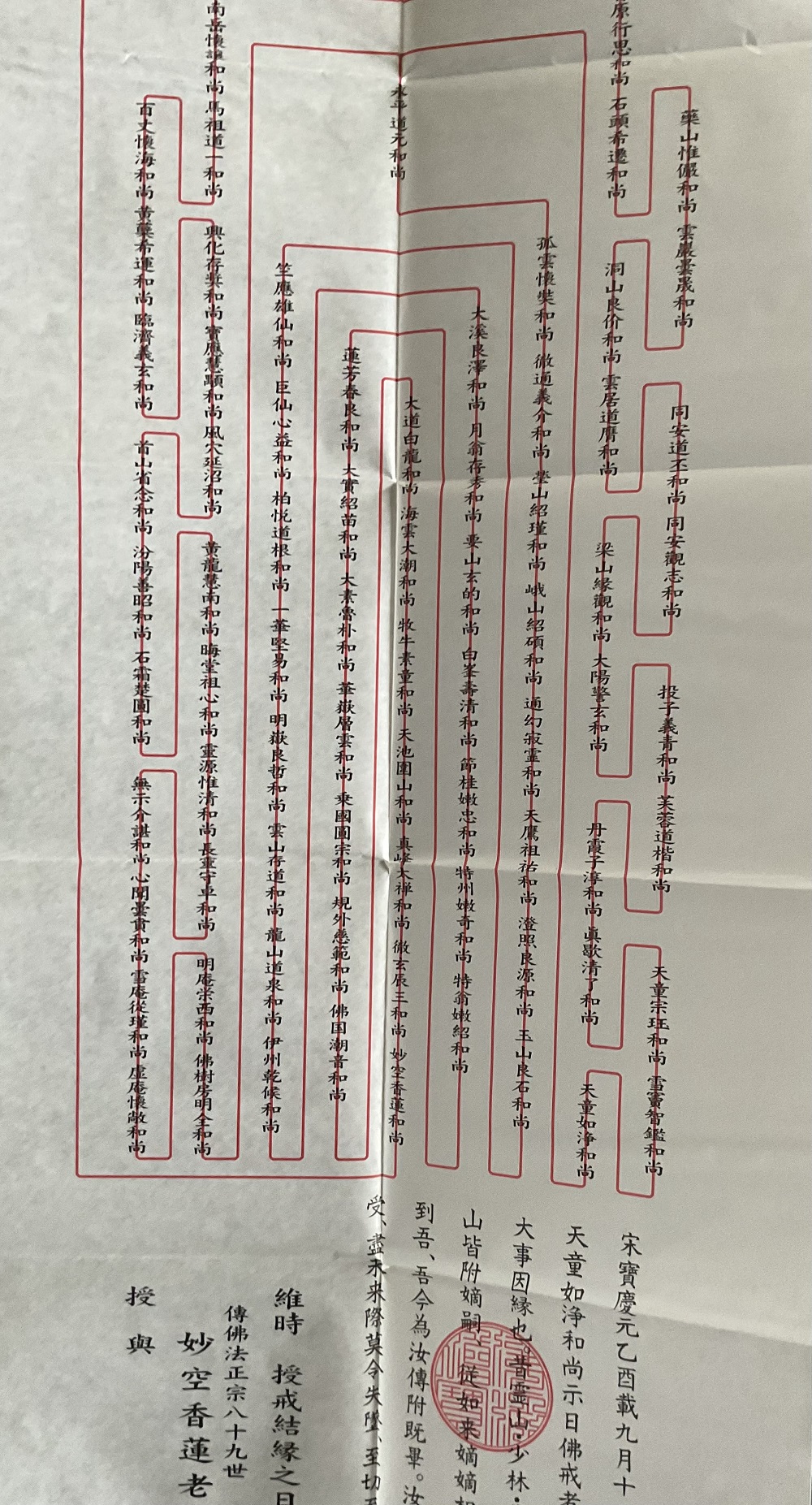ZEN MESTEREK ZEN MASTERS
« Zen főoldal
« vissza a Terebess Online nyitólapjára

江川辰三 Egawa Shinzan (1928-2021)
Nom de dharma: 徹玄辰三 Tetsugen Shinzan
![]()
https://www.bukkyo-kikaku.com/archive/no121_4.htm
https://ja.wikipedia.org/wiki/%E6%B1%9F%E5%B7%9D%E8%BE%B0%E4%B8%89
https://web.archive.org/web/20210924234939/https://www.sojiji.jp/honzan/kansyu.html
![]()

Tetsugen Shinzan 徹玄辰三 (Egawa 江川, 1928-2021)
25ème Abbé en chef (Dokujū) de Sōji-ji 总持寺独住 (2011-2021)
https://zensotobourgogne.fr/filiation/#egawa-shinzan-zenji
Egawa Shinzan naquit en 1928. Son père était abbé du temple de Seikôji. Il reçut l’ordination de moine en 1945 et la transmission du Dharma en 1949. Après des études littéraires et des études bouddhiques à l’université de Komazawa, il fit sa formation de moine à Sôji-ji, l’un des deux temples principaux de l’école Sôtô, à l’époque où Kôdô Sawaki y occupait le poste de godo (assistant de l’abbé pour l’enseignement des moines). En 1971, il devint abbé du temple de Hossenji, à Seto (près de Nagoya), où il ouvrit un dojo de pratique pour les laïcs. Par la suite, il fut nommé successivement kannin (moine cellérier) de Sôji-ji en 1996, kannin de Sôji-ji Sôin en 1999 et zenji (abbé) de Sôji-ji en 2011, fonction qu’il conserva jusqu’à sa mort en 2021.
D’un naturel chaleureux et enjoué, et d’une gentillesse communicative, il était très apprécié et respecté dans le zen Sôtô japonais. Bien qu’il eût le titre de shike (enseignant habilité à diriger un temple de formation monastique – sôdô), il avait coutume de privilégier la pratique plutôt que l’étude des textes et la réflexion philosophique. Il joua un rôle important dans le développement des échanges entre moines zen européens et japonais et dans la reconnaissance de la mission de maître Deshimaru. Bien qu’il fût très attaché à la pratique traditionnelle dans les temples japonais, dont il ouvrit les portes sans réserve aux Occidentaux qui le souhaitaient, il avait également conscience de la nécessité pour le zen européen de s’adapter aux conditions de la vie moderne.
Les disciples occidentaux d'Egawa Shinzan zenji

Pierre Crépon (1953-), nom de dharma: 道環 Dōkan (« Anneau du chemin » c'est « Pratique sans fin »*)
Abbé de Kokaiji, enseignant de l’école Sôtô (seikyoshi).
https://templezen-kokaiji.org/team/reverend-dokan-crepon/
https://www.facebook.com/templezensotokokaiji/
Né en 1953, Pierre Crépon commence la pratique à l’âge de 20 ans et reçoit l’ordination de moine de Maître 泰仙弟子丸 Taisen Deshimaru en 1975. Il devient l’un de ses proches disciples et suit quotidiennement son enseignement au dojo de Paris et lors de différentes sesshin dans toute l’Europe. Il est alors rédacteur en chef de la revue "Zen" de l’AZI (Association Zen Internationale) (de 1977 à 1987) et aide à l’organisation des camps d’été. Parallèlement, il poursuit des études universitaires d’histoire et d’archéologie.
Après la mort de Maître Deshimaru, en 1982, il continue de pratiquer au sein de l’Association Zen Internationale, dont il a été l’un des responsables, et dirige des sesshins au temple de La Gendronnière. Il quitte l’AZI en 2015. Il a été président de l’Union bouddhiste de France de 2003 à 2007.
Il s’installe avec son épouse Brigitte 清城 Seijô à Vannes en Bretagne en 1994 où ils créent un dojo zen qui devient le temple Kokaiji (古海寺 temple de l’Ancien Océan) en 2003. Dans le même temps il entreprend de renouer avec la tradition du zen japonais. Grâce au Révérend 堀部明宏 Myôkô Horibe qui avait été assistant de maître Deshimaru à Paris, il rencontre Shinzan Egawa Rôshi, alors administrateur (Kannin) du grand temple Sôjiji, dont il devient disciple et dont il reçoit la transmission du Dharma en 1998. Par la suite il continue de faire de nombreux voyages au Japon, séjourne dans différents temples et participe au rapprochement entre le zen européen et japonais.
Par ailleurs, en 1992, il fonde avec Brigitte les Éditions Sully, qui publient notamment des ouvrages sur le bouddhisme (comme la traduction par 折茂洋子 Yokô Orimo du Shôbôgenzô de maître Dôgen) et sur la culture japonaise. Il est également l’auteur de nombreux articles et de plusieurs ouvrages (Dictionnaire de la spiritualité orientale, Les Fleurs de Bouddha, Pratiquer le zen, Contes et paraboles du Bouddha).
Il a donné la transmission du Dharma à Marie-Odile Reimyô Blaise, responsable de la couture du Kesa au temple, et à Alix Myôshô Helme-Guizon, responsable du dojo zen d’Angers.
Extrait du livre Pratiquer le zen (1996)
Sa bibliographie aux éditions Sully:
Contes et paraboles du Bouddha
Dictionnaire pratique de l'acupuncture et du shiatsu
L'art du zazen
S'oublier soi-même en suivant la voie du zen

Katia Robel (1948-), nom de dharma: 妙空香蓮 Myōkū Kōren (« Merveilleux vide, Parfum de lotus »)
Ordonnée nonne en 1971 par maître Taisen Deshimaru, Katia Kôren Robel reçoit en 2003 la transmission du Dharma du grand maître Shinzan Egawa. Présidente de l’Association Zen Soto, elle enseigne principalement au temple de Myô-Unji en Bourgogne et à Paris.
https://zensotobourgogne.fr/enseignants/
https://associationzensotoparis.fr/qui-sommes-nous/katia-koren-robel/
Dès 1970, Katia Kôren Robel pratique quotidiennement zazen à Paris sous la direction de maître Taisen Deshimaru. Ce dernier lui confère l’ordination de nonne en 1971. Pendant les années qui suivent, elle travaille notamment à la publication de ses textes. Après le décès de maître Deshimaru en 1982, elle commence à enseigner le zen au Dojo Zen de Paris, puis au temple zen de la Gendronnière et dans des retraites (sesshin) en France et en Europe. En 2003, elle reçoit la transmission du Dharma (shihō) de maître Egawa Shinzan et devient enseignante certifiée (kyoshi) de l’école Sôtô japonaise.
Présidente du Dojo zen de Paris de 1996 à 2006, elle a ensuite créé l’Association zen Sôtô (AZS) et enseigné au Dojo zen du Châtelet, à Paris, jusqu’en 2020. Elle est aujourd’hui présidente de l’AZS, membre du conseil spirituel de l’Association zen Internationale (AZI) et membre du conseil d’administration de l’Union Bouddhiste de France (UBF). Elle enseigne principalement au temple de Myô-Unji et à Paris.

https://sotozen.actibookone.com/content/detail?param=eyJjb250ZW50TnVtIjoxNzYxMDJ9&detailFlg=0&pNo=8
佛祖正傳菩薩大戒血脈
Busso shōden bosatsu daikai kechimyaku
The Bloodline of the Buddha’s and Ancestors’ Transmission of the Great Bodhisattva Precepts[…]
永平道元 Eihei Dōgen (1200-1253)
孤雲懐奘 Koun Ejō (1198-1280)
徹通義介 Tettsū Gikai (1219-1309)
螢山紹瑾 Keizan Jōkin (1268-1325)
峨山韶碩 Gasan Jōseki (1275-1366)
通幻寂靈(=灵) Tsūgen Jakurei (1322-1391)
天鷹祖祐 Tenyō Soyū (1336-1413)
澄照良源 Chōshō Ryōgen (1354-1427)
玉山良石 Gyokusan Ryōseki
竺翁雄山 Chikuō Yūsen
巨川心益 Kyosen Shinyaku
柏悅道根 Hakuetsu Dōkon
一華堅易 Ichike Keneki
明岳良哲 Meigaku Ryōtetsu
雲山存道 Unsan Sondō
龍山道泉 Ryū Dōsen
位州乾候 Ishū Genkō
大渓良澤 Takei Ryōtaku
月翁存秀 Gatsuō Sonshū
要山玄的 Yōsan Genteki
白峰寿清 Hakuhō Jusei
節桂嫩忠 Setsukei Donchū
特州嫩奇 Dokushū Donki
霊峰嫩紹 Reihō Donshō
連峯春良 Renhō Shunryō
大實紹苗 Tajitsu Shōmyō
太素魯朴 Taso Roboku
華嶽層雲 Kagaku Sōun
乗国圓宗 Jōkoku Enshū
規外慈範 Kigai Jihan
佛国潮音 Butsukoku Chōin
大道白龍 Taidō Hakuryū
海雲大潮 Kaiun Daichō
牧牛素童 Bokugyū Sodō (石川 Ishikawa, 1841-1920) (4. Chief Abbot (Dokujū) of Sōji-ji 总持寺独住)
天池圓山 Tenchi Ensan
東峰太禅 Tōhō Taizen
徹玄辰三 Tetsugen Shinzan (江川 Egawa, 1928-2021) (25. Chief Abbot (Dokujū) of Sōji-ji 总持寺独住)
妙空香蓮 Myōkū Kōren (Katia Robel 1948-)

Situation of the diffusion of Zen in Europe
by Rev. Koren Robel
Dharma Eye, Soto Zen Journal. March 2022, No. 49. pp. 8-10.In just over fifty years, from north to south,
from Norway to Spain, and from west to east,
from Portugal to Poland, Zen has spread throughout
Europe. It was in 1967 that the practice of
Zen was established in Europe thanks to the
arrival of the Zen monk of the Rev. Taisen Deshimaru
in Paris. He did not come to take care of
Japanese communities as was the case with the
first Zen monks in America. He came on his own
initiative in a missionary spirit to spread Zen
practice and philosophy in the West.Rev. Taisen Deshimaru was an atypical
monk. He was endowed with great charisma,
unshakable energy and faith, and a deep knowledge
of both human beings and the Zen tradition
and Far Eastern culture. His mission, which
lasted fifteen years, was a great success. Settled
in Paris, his teaching spread throughout Western
Europe. He firmly established the practice of
zazen, translated the great Zen texts, and introduced
rituals and chants. He was responsible for
the creation of more than a hundred dojos and
practice groups throughout Europe, as well as
the Gendronnière temple in 1980 in the Val-de-
Loire, France. He was the first kaikyosokan in
Europe in 1976, and from then on, many Japanese
delegations came to visit him and several
young Japanese monks came to help him. He
gathered many disciples around him, ordaining
more than 500 monks and nuns, and it is said
that more than 20,000 people have at one time
or another practiced with him. In 1970 he
founded the European Zen Association, which
became the International Zen Association (IZA)
in 1979. Forty years after his death in 1982, his
memory and energy remain very much alive and
underpin the situation of Zen in Europe.Rev. Taisen Deshimaru passed away in 1982,
having trained disciples but not given Dharma
transmission. In the years that followed, and
although several disciples received transmission
from other Japanese masters fairly quickly -
notably Rev. Shuyu Narita and Rev. Renpo Niwa
Zenji - the situation was somewhat confused and
different choices were made concerning the relationship
with the Japanese tradition, the transmission
and the relationship with the Soto
School. Some of his former disciples remained
and still remain fiercely opposed to any affiliation
with the institution (Shumucho). For about
twenty years, there was no kaikyosokan or European
office of the Soto School in Europe.Finally, things became clearer from the end
of the 1990s. Most of Master Deshimaru’s
disciples, who had become teachers, returned to
Japan and received the transmission from various
Japanese masters. As other Europeans went
to practice in Japanese temples (Eiheiji, Sojiji,
Sojiji Soin, Eiheiji Betsuin, Nisodo, Antaiji, etc.)
and also received transmissions, there are a
large number of lineages in Europe from different
Japanese masters. There are also some
lineages from the United States. Since 2002, a
new European office of the Japanese school has
been set up, first in Milan and then in Paris,
which has created a link between these different
lineages. Training seminars, organised by the
Sokanbu at the Gendronnière temple, regularly
bring together oshos, kyoshis and kokusai
fukyoshis from all over Europe, who can on
these occasions meet, get to know each other
and have exchanges. The hossenshiki and shinzan
ceremonies, organised in the temples, are
also the occasion for regular meetings, as are the
two ojukai ceremonies, led by Rev. Minamizawa
Zenji, which took place for the first time outside
Japan in 2016 at the Gendronnière and in 2019 at
Kanshoji, and the commemoration ceremonies.Today, the second-generation teachers generally
follow the classical Soto school curriculum
and go to practice ango in the sodo in Japan,
mainly in Toshoji (Okayama prefecture). There
were two shuritsu senmon sodo at the Gendronnière
in 2007 and 2008, organised by the Sotoshu
Shumucho for the first-time outside Japan, and
with the presence of teachers such as Shohaku
Okumura. But since then, the ango held in various
temples are not yet officially recognized by
the school for the training of monks. There are
currently several Soto School temples in Europe,
some of which are monastery-type temples in
the countryside and others in the city.There are also a large number of groups who
voluntarily keep away from the Soto School and
its rules, because they want to preserve their
independence at all costs and create a "European
Zen" with its own forms, "independent"
lineages, while practicing zazen and simplified
rituals. Since some of the teachers are affiliated
with the school and others are not, these risks
creating confusion and difficulties for the future,
even though the form of the practice is mostly
the same.In fact, the living fabric of Zen in Europe is
made up of a great many small practice groups
scattered around the cities, as well as isolated
individuals, and then a few dozen dojos and
larger centers and a few temples, all run by
monks and nuns and teachers (65 kyoshis, 52
kokusai fukyoshis). All these people and places
of practice are generally organized in a network,
linked to a temple or a teacher, within an association
or not. The International Zen Association,
founded by Master Deshimaru, is probably
the most important - it has more than 1,100
members and 9 temples, 9 zen centers, 73 dojos
and 129 groups - but there are others, in Germany,
Italy, Belgium, etc.The great diversity of lineages, associations,
and of course countries with different languages
and cultures, does not prevent a certain unity of
European Zen, such as the central place of
zazen, the black koromo, the sewing of the kesa,
the teaching of Zen texts and the practice of
traditional rituals, more or less advanced, most
often using the recitation of sutras in Sino-
Japanese. In general, European Zen groups are
not overly concerned with social affairs and do
not get involved in political affairs. They also
differ from many other mindfulness-type groups,
and preferably follow a traditional form appropriate
to the circumstances.The last two years have obviously been a bit
complicated with the Covid pandemic. Some
groups have adopted video-conferencing teaching,
others have not. At the moment, we are
hopeful that this pandemic will end and that
second-generation teachers will be able to train
in Japan again, that it will be possible to do
zuise there again and that the number of kyoshis
will increase, thus showing the vitality of Zen.